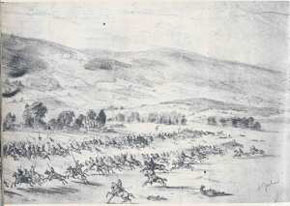Civil War Battles |
Colonial Wars |
American Wars |
Link To This Page — Contact Us —
The Battle of Upperville
June 21, 1863 in Upperville, Virginia
Gettysburg Campaign
Union Forces Commanded by:
Maj. Gen. Alfred Pleasonton
Confederate Forces Commanded by: Brig. Gen. Wade Hampton and Brig. Gen. Beverly Robertson
**Missing and Captured Conclusion: Inconclusive Victory |
 |
BATTLE SUMMARY
At the time of Gettysburg, Maj. Gen. Alfred Pleasonton commanded the Union cavalry attached to the Army of the Potomac. In June, Pleasonton's cavalry had surprised Brig. Gen. J. E. B. Stuart's men at Brandy Station, where Stuart's troops were massing to screen Gen. Robert E. Lee's Army of Northern Virginia as it headed north into Pennsylvania. After initially giving ground, Stuart's troops rallied and took back the field, making the contest a draw. However, Brandy Station was a 'moral' victory for the Union. For the first time the Union cavalry proved to be the equal of the Confederate.As the Army of Northern Virginia made preparations to advance into the North. Stuart's cavalry corps was assigned the task of securing the passes in the Blue Ridge Mountains and masking the movement of Lee's Army.
On June 21, Union cavalry, buoyed by their recent success, made a determined effort to pierce Stuart's cavalry screen. Brig. Gens. Wade Hampton's and Beverley Robertson's Confederate brigades made a stand at Goose Creek, west of Middleburg, and beat back a Union Cavalry division under Gen. J. I. Gregg.
Brig. Gen. John Buford's cavalry column was ordered to attack the Confederate left flank near Upperville but encountered Brig. Gens. William E. "Grumble" Jones' and John R. Chambliss's Confederate cavalry brigades. Meanwhile Gregg's brigade and that of Brig. Gen. Judson Kilpatrick advanced on Upperville from the east along the Little River Turnpike. After furious mounted fighting, Stuart withdrew his cavalry corps to take a strong defensive position in Ashby Gap, an important mountain pass. As cavalry skirmishing diminished the Army of Northern Virginia safely crossed the Potomac River into Maryland.
On its face, the actions at Upperville were inconclusive. As cavalry skirmishing diminished, Stuart made the fateful decision to strike east and attempt a 3rd circuit of the Union army as it marched toward Gettysburg. Stuart's absence on the first 2 days at the Battle of Gettyburg is often cited as a cause for the Confederate defeat on the 3rd day.
Ironically, it was the presence of John Buford's cavalry at Herr Ridge and their stubborn defensive retreat on the 1st day of Gettysburg that may have saved the "high ground" of Cemetery Ridge and the Round Top's for the Union army.
